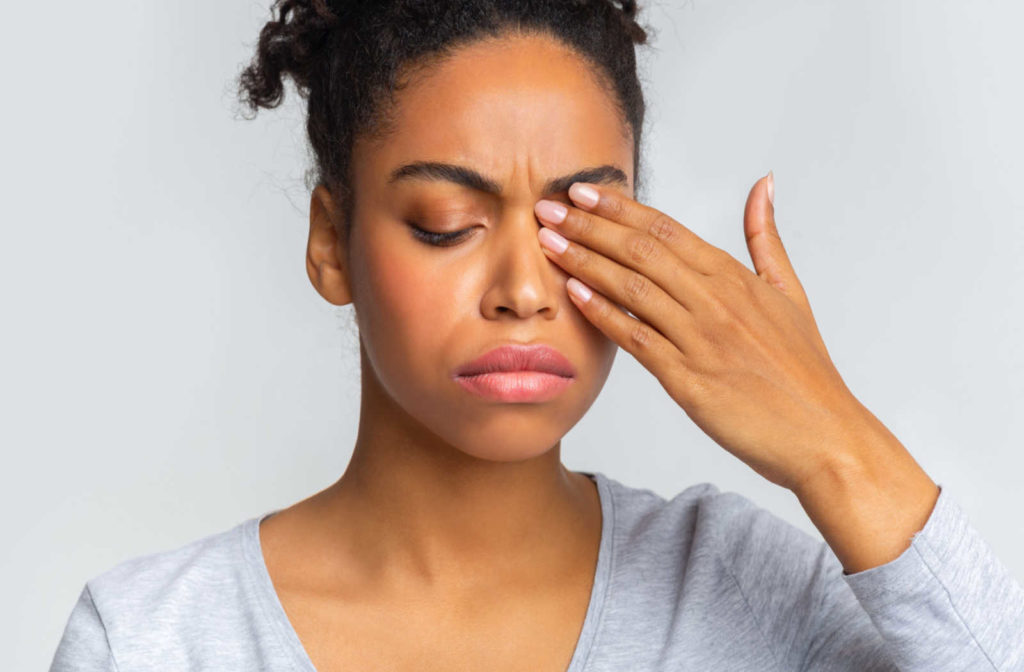About Blinking & Eye Problems
Blinking, like breathing, is a reflex. While we can control it to some extent, we usually don’t think about it. The average person blinks 900–1,200 times an hour. A blink lasts about 0.1–0.4 seconds, accounting for 10% of the time you’re awake. When your eyes feel sore when you blink, that can add up to a lot of discomfort.
Experiencing pain when you blink can indicate an eye problem, including eye infections, injuries, or dry eye. When blinking soreness or eye discomfort persists, it’s crucial to schedule an eye exam as soon as possible.
How Eyelids Work
While your eyes do most of the work for your vision, eyelids also play a significant role. Your eyelids protect your eyes, prevent infection, and spread moisture across the cornea.
The outermost layer of your eyelids is a thin layer of skin. It protects the muscles, nerves, and glands from infection or injury. However, there’s little fat to cushion the eyelid, making the eyelid more prone to swelling or bruising.
The muscles in your eyes control blinking. Your eyes close to avoid bright light or prevent foreign objects (like dust) from entering the eye. Blinking shields your eyes while you sleep and stimulates the movement of tears. You might also blink one eye—a wink—as a nonverbal form of communication.
Glands in the eyelid secrete the moisture and lubrication the eye’s surface needs to function effectively. Eyelid glands also release sweat to support evaporative cooling.
Blinking & the Tear Film
Blinking spreads basal tears across the eye, forming the tear film. The tear film cleans debris, supplies oxygen, provides moisture, and delivers nutrients. We need a consistent, healthy tear film to keep the eye’s surface nourished and smooth.
The tear film is made of 3 layers:
- Inner mucus layer: helps the tear stay on the eye’s surface.
- Middle watery layer: the thickest layer hydrates the eye and washes away bacteria or foreign objects (dirt, dust, etc.).
- Outer oily layer: keeps the eye’s surface smooth to help light enter the eye and prevent tears from evaporating too quickly.
An eye problem, health condition, or environmental factor can interfere with tear production and cause dry eye. While dry eye may not cause soreness initially, it can cause burning and stinging sensations. Chronic dry eye also leads to infections, eye damage, and impaired vision.
Chronic or severe dry eye is common, affecting millions of Americans. Although dry eye can cause your eyes to feel sore when you blink, there are also causes to consider.

Causes of Blinking Soreness
When your eyes feel sore, there are many potential causes. For example, you may experience eye pain when you blink because the cornea (the eye’s surface) is irritated or because of inflammation in the surrounding tissue. Even contact lenses can irritate eyes because of infection or high eye sensitivity.
Your eye doctor must evaluate your eyes and discuss your symptoms to determine the cause. Your eyes are unique, so it’s crucial to make a diagnosis based on updated, personalized information.
Common causes of blinking soreness include:
- A foreign object in the eye
- Blepharitis
- Cluster headaches
- Conjunctivitis (pink eye)
- Corneal abrasions
- Corneal ulcers
- Eye allergies
- Eye or face trauma
- Glaucoma
- Hordeolum (stye) or chalazion
- Iritis or keratitis
- Vision changes
Diagnosing the Cause
Before treating your sore eyes, your eye doctor will examine your eyes and discuss your symptoms. The more your optometrist knows about your unique eye health, the better they can personalize your treatment.
In addition to soreness, other common related symptoms include:
- Difficulty closing your eyelids
- Pain when moving eyes
- Increased eye pressure
- Eyelid inflammation
- Light sensitivity
- Tenderness around eyes
While eye soreness caused by blinking can be temporary, seeking medical attention is crucial to reduce the risk of long-term health problems. Booking an appointment for mild soreness or swelling can help prevent worsening symptoms. However, please contact your eye doctor for emergency eye care if symptoms are severe.
Treating Blinking Discomfort
Your eye doctor will recommend treatment based on their diagnosis. For example, your optometrist may prescribe medicated eye drops or ointment for eye infections, such as conjunctivitis, corneal ulcers, iritis, and keratitis.
Chronic conditions, such as blepharitis, eye allergies, or dry eye, may require a combination of short-term and long-term relief treatments. For example, dry eye therapy methods include artificial tears, eyelid cleaners, punctual plugs, or warm compresses. Contact lens wearers may also benefit from switching to scleral lenses.
Treating eye soreness can be a process. When multiple eye problems or lifestyle factors cause symptoms, diagnosing and treating each issue can take more time. Your eye care team can develop a customized plan that meets your eye care needs.
Relief for Blinking Soreness
Protecting your eyelids and eyes is more than a reflex. Blinking is an essential aspect of eye health and should never hurt. When you’re experiencing soreness or discomfort when you blink, contact the Dr. Henslick Vision Center. We can help you manage your eye care and prescribe solutions to preserve your vision. Request an appointment with us today!




